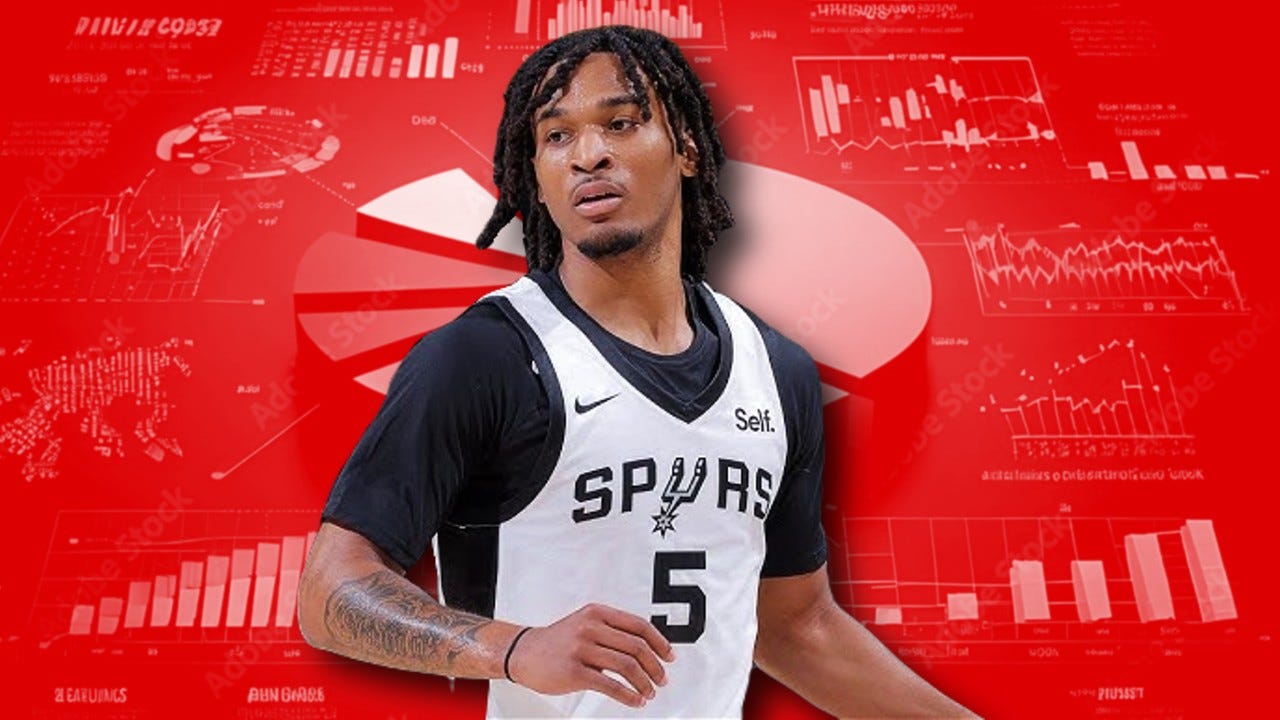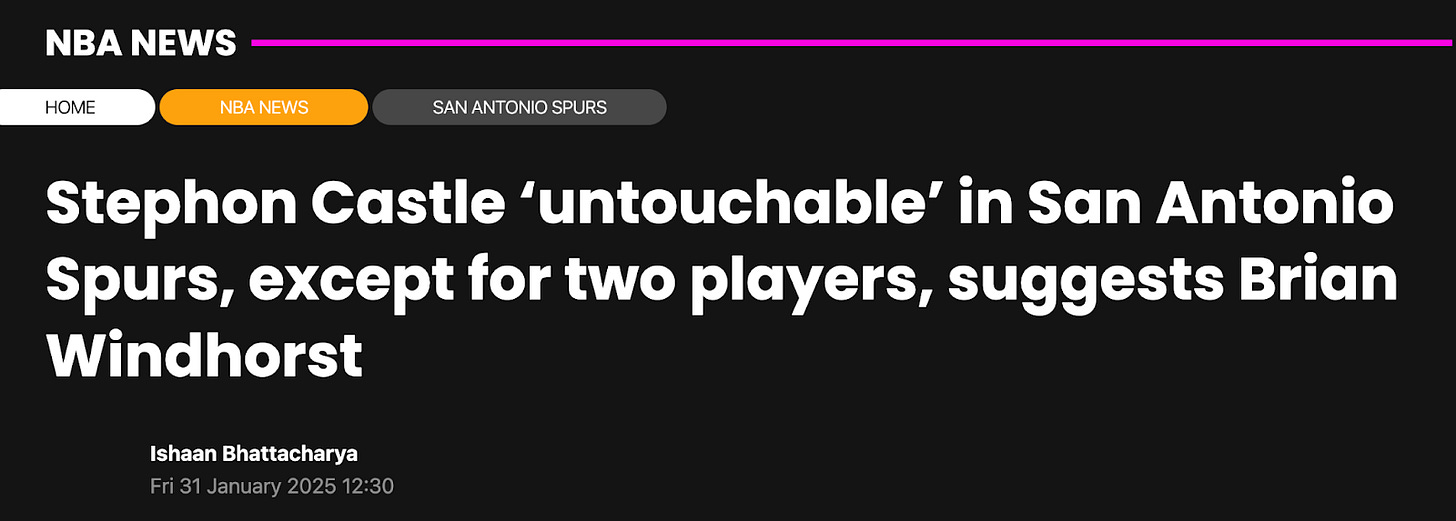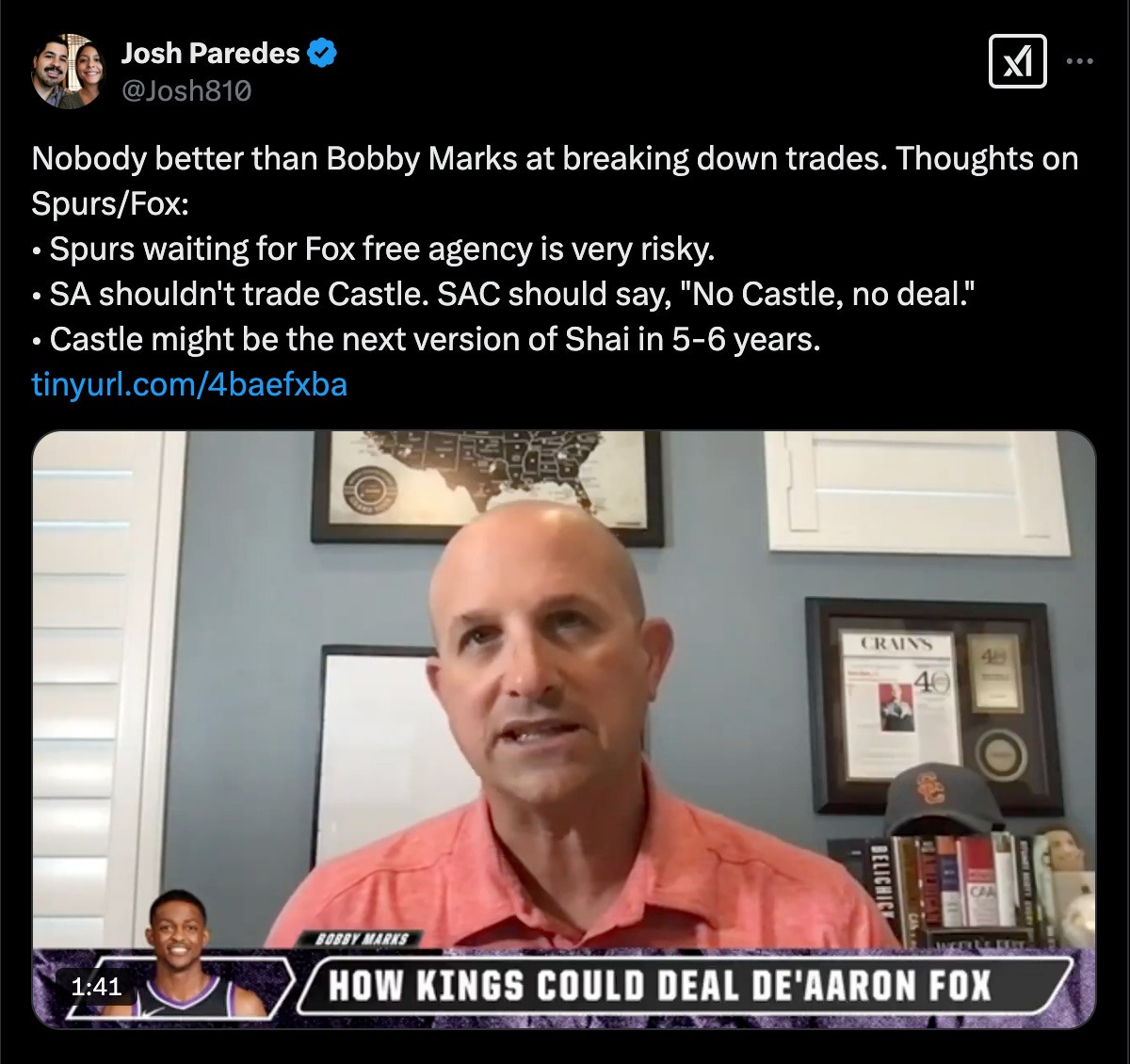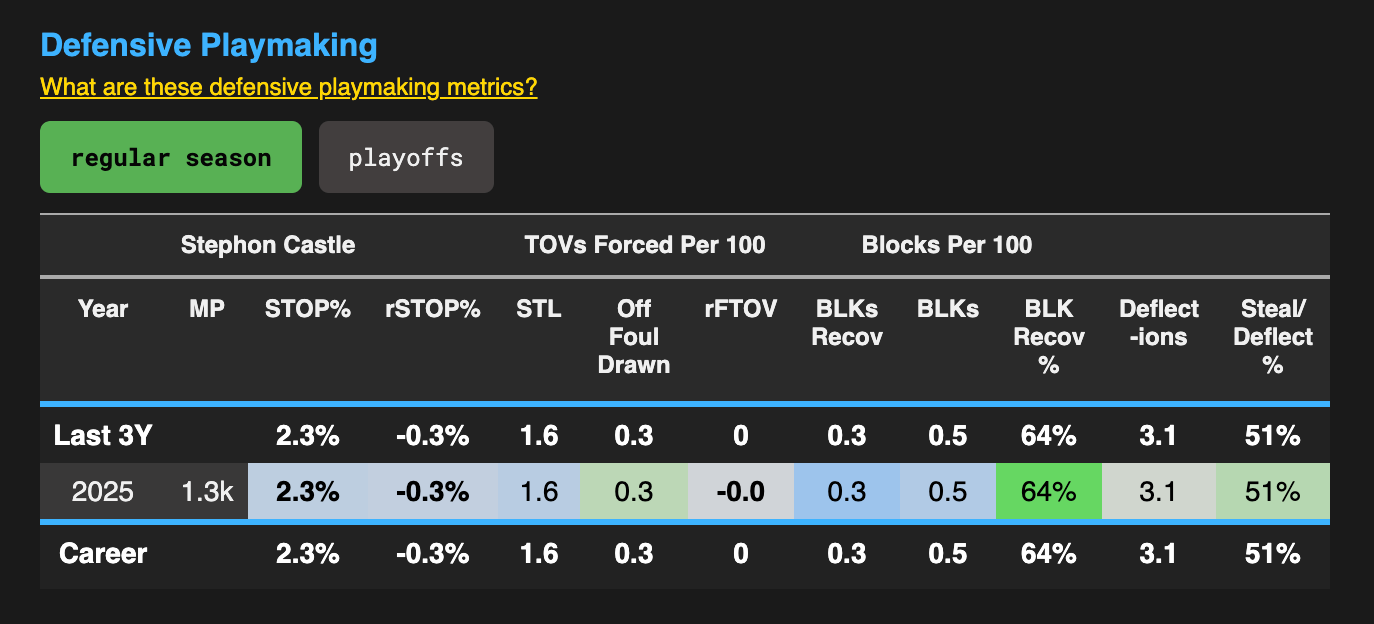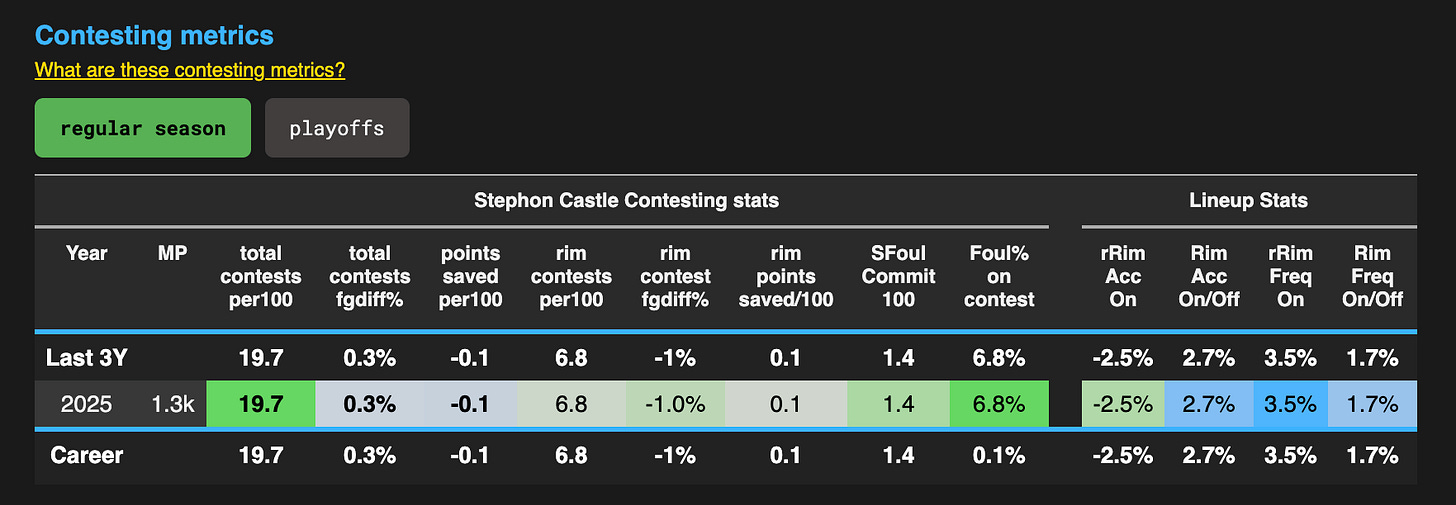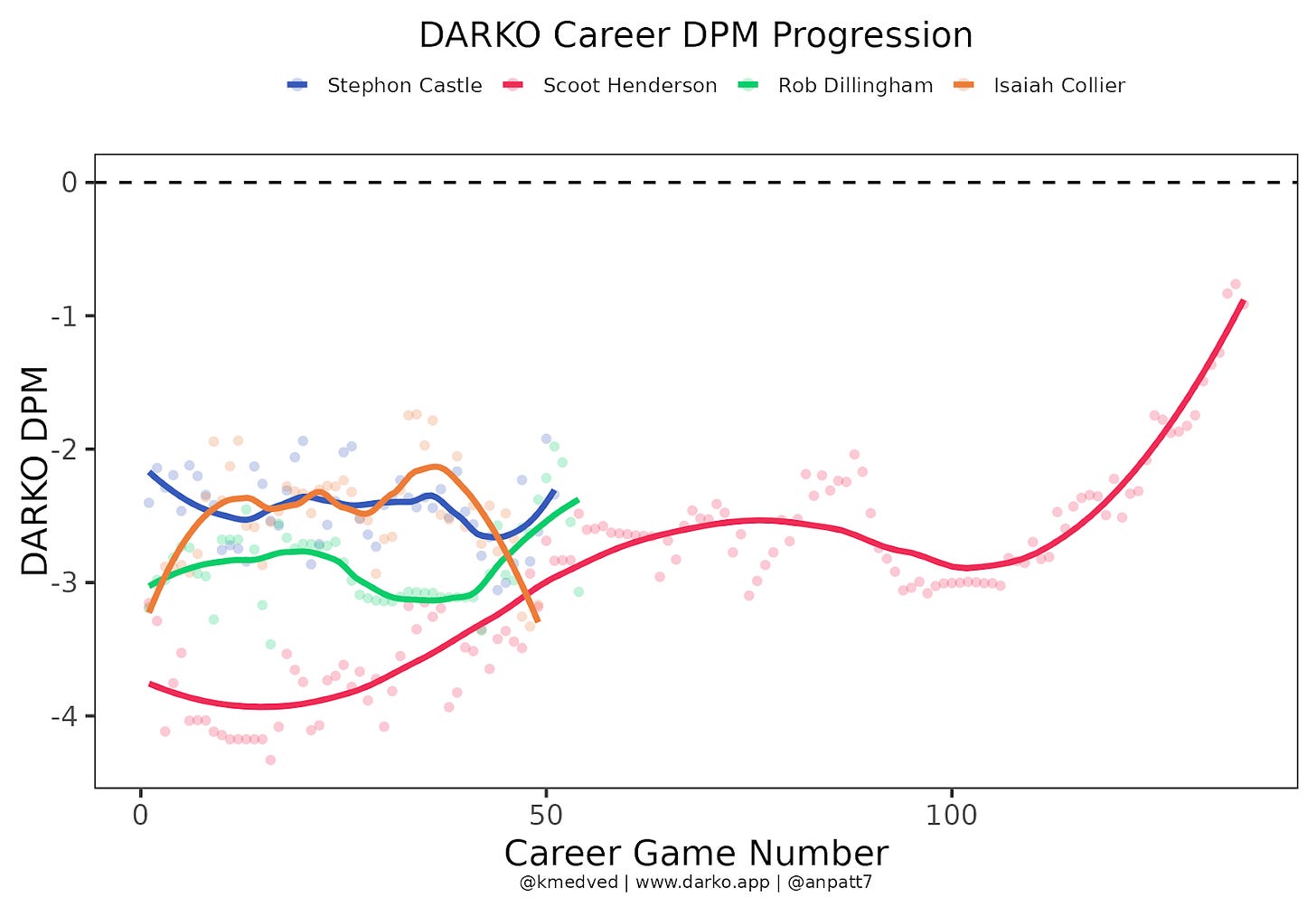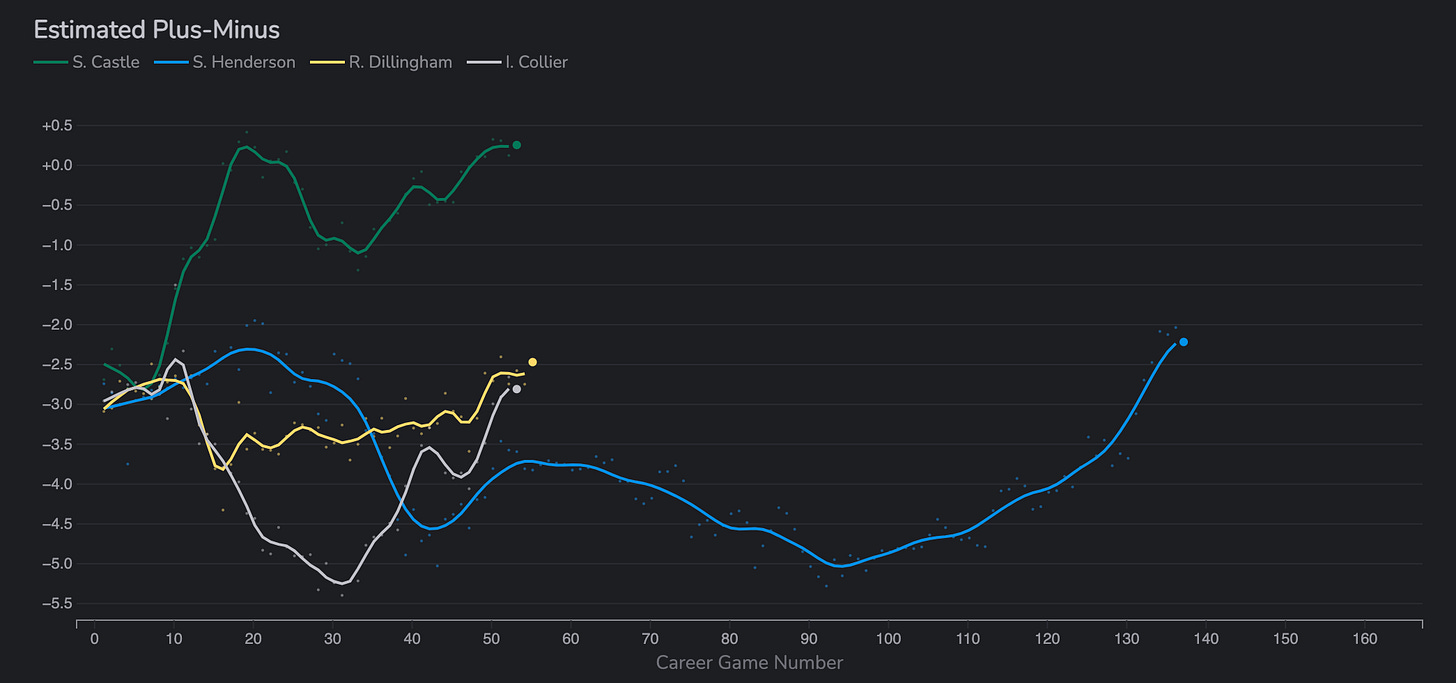Stephon Castle: When the Film and the Analytics Clash
Stephon Castle has received a ton of hype, but is it deserved? Here's why the film and analytics paint a very different picture of his rookie season.
The San Antonio Spurs’ rookie guard Stephon Castle has quickly become one of the most highly regarded players from the 2024 NBA Draft. Many NBA fans have raved about his performance this season, especially over the last few weeks, as he’s averaged around 18/4/3 per game on 48.9% shooting from the field and 36.8% from three across his last 14 games.
The excitement about the young guard reached new heights shortly before the trade deadline as ESPN’s Brian Windhorst reported the Supurs viewed Castle as untouchable in trade discussions except for Luka Doncic and Shai Gilgeous-Alexander. Even Bobby Marks claimed that Castle might be the next version of Shai in 5-6 years.
Despite this, many people have questioned the hype, pointing out that there are major red flags with his statistical profile. Stephon Castle is a unique player whose film shows flashes of brilliance while his production leaves a lot to be desired. Eye test truthers view him as a future star, while stat nerds think it’s more likely he will become just a role player or maybe even a solid starter Let’s take a closer look at both the film and the numbers to figure out just how good Stephon Castle is.
One of Stephon Castle’s biggest strengths at the moment is his ability to get inside the paint. He is an explosive athlete with a solid handle, and he utilizes these two traits to generate paint touches at an extremely high rate.
Castle’s film is filled with examples of him getting to the paint with ease and throwing down dunks. This is also reflected in his data. For example, 43% of his field goal attempts are at the rim, a mark that ranks in the 95th percentile for his position. On top of this, he has a free throw rate of 0.318, which is very solid for a young guard.
One of the best ways for guards to generate efficient offense is to get to the rim and the free-throw line often. Castle has yet to be an efficient scorer, something we’ll get into later on, but he clearly has a gift for attacking the basket.
Unfortunately, Castle’s finishing is far from perfect. When he attacks the basket aggressively, it looks like he can be an elite rim finisher. However, he struggles to put the ball in the basket when he isn’t dunking the ball or attempting a layup, and there are times when he’s forced to take extremely difficult shots around the basket, leading to some ugly misses.
Castle’s ability to get to the rim is impressive, but his ability to actually convert on these attempts is questionable. This season, he is shooting just 62% at the rim and 37.4% from 3-10 feet, both underwhelming marks even for a guard. If he ever wants to be a truly great player, he needs to improve as a rim finisher.
While his finishing is unpolished, I’ve liked what I’ve seen from him as a passer. He is great at driving to the basket, drawing extra defenders towards him, and then kicking the ball out to open shooters. He has also shown the ability to make skip passes off the dribble, something that some of the best passers in the game do with extreme regularity.
His passing numbers have been solid this year, too. He has an assist rate of 20.6% and an AST:TO of 1.84 while sporting an on-ball rate of 26%. He handles the ball at a fairly high rate for a rookie, and he generates assists fairly often while doing a very solid job of limiting turnovers. His passing volume isn’t good enough for him to be considered a. great passer yet, but his playmaking has been solid for a rookie,
Castle deserves a lot of praise for his ability to get to the rim and pass the ball. These are clear strengths in his game right now. However, I think there are a lot of red flags that are worth discussing too.
Let’s talk about Castle’s perimeter shooting. Over the last 14 games, he has looked like a very solid shooter, hitting 36.8% of his 4.1 three-point attempts per game while also shooting 76.6% from the free-throw line. I’ve also been impressed by some of the film I’ve seen of him shooting from distance. I have seen multiple examples of him hitting off the dribble jumpers out of pick-and-rolls, which could be a high-level skill if this becomes a strong part of his game.
Castle’s recent stretch of hot shooting and enticing film as an off-the-dribble shooter could lead some to believe that he has a chance to be a good shooter. Unfortunately, I have to be the bearer of bad news: Stephon Castle is not a very good shooter.
This season, he is shooting just 30% on long twos, and he is shooting just 28.8% from three with a free throw rate of 0.351. Those are very poor shooting percentages and there is no avoiding this. To make things even worse, he’s been bad shooting off-the-catch and off-the-dribble, making just 30.1% of his catch-and-shoot threes and just 25.9% of his pull-up threes. He has also made just 30.9% of all of his jump shots.
His poor rim finishing and perimeter shooting are why he has a terrible TS% of just 51.4%. His scoring efficiency is about 11% below league average, and this is a major problem. Quality NBA players are not this inefficient as a scorer. If Castle ever wants to play a lot of minutes for a winning team, he has to improve as a rim finisher and/or a shooter.
I know that was a lot of numbers, but I present this data to show you that Castle has been disastrous as a shooter this season. Perhaps he can improve a lot in this area moving forward, but there’s no denying that he has been a terrible shooter this season. I’m also doubtful that he ever improves that much because he was a very questionable shooter in college as well.
I’m clearly not a fan of Castle’s shooting, and I have similar feelings about his defense. I have seen plenty of people hyping up his defense, but I would argue that he has been underwhelming on this end of the floor.
Typically, guards who are strong defenders provide value by ending positions, whether it be by stealing the ball or blocking shots. Unfortunately, Castle doesn’t shine in either of these areas. This season, he is averaging just 1.6 steals and 0.5 blocks per 100 possessions. He also has a stop rate of just 2.3%, and all of these numbers are quite low for a guard who’s largely considered a strong defender. It’s really hard to be an impactful defender in this position without wreaking havoc and forcing turnovers.
To be fair, though, Castle has been quite good at contesting shots. He contests 19.7 shots per 100 possessions, and opponents shoot 1% worse at the rim when he contests the shot. On top of this, he commits a foul on just 6.8% of his contests. These numbers strong for a guard, though I’m not sure this is that valuable for this position. The value of these contesting metrics would be different if we were talking about a big man who’s an above-average rim protector.
I believe this is why some of his defensive impact metrics are extremely underwhelming. For example, nbarapm.com combines a handful of impact metrics to estimate how many points each player is worth per 100 possessions. This stat is called VPM, and the defensive version of this stat estimates that Castle’s defense is worth approximately 0 points per 100 possessions, a mark that ranks 214th. This shouldn’t be taken as gospel, of course, but I find it hard to be high on Castle’s defense when a lot of his numbers on this end of the floor are so questionable.
Speaking of impact, I want to stay on this topic. When evaluating young players, it’s important to differentiate how good they are now vs. how good we can reasonably expect them to be in the future.
At the moment, I don’t believe Stephon Castle is a good NBA player yet. A few of the most popular impact metrics, box plus-minus, estimated plus-minus, and LEBRON view him as being an average player at best and an atrocious player at worst.
Box Plus-Minus: -4.0 (175th)
Estimated Plus-Minus: -0.9 (52nd percentile)
LEBRON: -1.7 (481st)
I think there is also a major red flag when looking at how the Spurs perform when he is on the floor without the support of Victor Wembanyama, one of the top players in the league. This season, this pair has played 761 minutes together, and the Spurs have been very solid with this duo, sporting a net rating of 2.9.
With Wemby on the floor and Castle on the bench, the Spurs still perform well, outscoring opponents by 3.45 points per 100 possessions. This completely changes when Castle is on the floor without Wemby, though. In the 518 minutes that Castle has played without Wemby, the Spurs have had a net rating of just -5.87, which is awful.
In my opinion, raw plus-minus overrates Castle because he plays with Wemby so much, and Wemby is a legitimate MVP-caliber player. The Spurs perform well whenever Wemby is guiding the ship, so it’s no surprise that they perform well when this pair plays together. The Spurs’ poor net rating with Castle on the floor and Wemby off the floor indicates that Castle may not be a very impactful player right now.
At this point, I believe I’ve put together a good case for why Stephon Castle isn’t a good player at the moment, but what does his future projection look like? Based on the data, the possibilities seem mixed.
DPM is a plus-minus metric that uses past performance, with recent performances being weighted more, to project how a player will perform in the future. This metric operates differently than most plus-minus metrics because it’s forward-facing rather than describing the past.
Below is where this stat views Castle in relation to a few other young guards who have all been drafted in the last two years. His DPM is very low right now, but it’s interesting that his early career production has been way better than Scoot Henderson’s, who appears to be taking a massive leap.
While DPM is extremely low on Castle, expected estimated plus-minus is not. Expected EPM is the forward-facing version of EPM, which attempts to do the same thing that DPM does. As you can see below, this metric has a more favorable view of Castle relative to the players I compared him to in the graph above.
I love looking at stats like this to learn what analytical projections think of specific players and their futures. In the case of Stephon Castle, it appears these stats view him as a struggling young player with a realistic shot at developing into a quality player who’s well above league average in terms of statistical impact.
Stephon Castle is a fascinating player to evaluate. On the one hand, I found his film to be exciting and saw the potential that a lot of people see when they watch him play. The driving, passing, and pull-up shooting flashes were all great to see and honestly surprised me. Unfortunately, his production includes many warts that you could miss if you only watch a handful of his games.
Through this breakdown, my thoughts on Castle have changed a little bit. I’m a bit more optimistic about his future due to his ability to generate rim attempts and pass the ball while being so young and getting so many on-ball reps. Unfortunately, I’m extremely worried about his scoring efficiency and defensive playmaking. Because of these red flags, I tend to be less excited about his upside than many NBA fans.
Hopefully, he will take a big step forward in the future and develop into an impactful NBA player. It wouldn’t surprise me if this happens, but I strongly doubt that he ever becomes an all-star caliber player. I would need to see more from him as a rookie to think he has the potential to be one of the top players in the game. Still, there are parts of his game that I have underrated in the past, and I have begun to see the light little by little.




